Geoscience Reference
In-Depth Information
associated with the European Mountain Biosphere Reserves that had participated
in the GLOCHAMORE project to attend a meeting in Zurich (May 3-4, 2006) to
translate the GLOCHAMORE strategy into a programme appropriate for Europe.
The assumption underlying this approach was that the global change related issues
were more completely owned by those managers than by disciplinary scientists.
These managers would therefore have an interest in promoting an inter- and trans-
disciplinary research programme in their Biosphere Reserves and in linking those
programmes together into a network. For manifold reasons, the hoped-for launch of
a global change research network in European mountains did not, however, ensue
from this meeting. The assumption that Biosphere Reserve managers were central
to the implementation may have been simply wrong. Some Biosphere Reserves had
long, rich histories of research, and it is plausible that those managers saw no par-
ticular benefit to them or their constituencies in “standardizing” research at their
sites to some international standard. In other sites, research was but one of many
management concerns, usually of lower priority. In yet others, the site was essen-
tially managed by researchers and therefore had no administrative apparatus through
which stakeholders could make their concerns manifest. Thus, while Mountain
Biosphere Reserves remained quite logical sites for Global Change research, their
management did not prove to be a useful starting point.
Thereafter, MRI took quite a different approach, one focused on scientists,
regardless of their affiliation with place, and on funding. MRI announced another
meeting for February 1-2, 2007, on global change in European mountains, but this
time with a sub-title emphasizing funding through the European Commission's 7th
Framework Programme for Research and Development (FP7). Furthermore, it made
no assumptions regarding an optimal structure for implementation, but rather asked
researchers how they wished to proceed. This meeting drew ten times as many par-
ticipants as the earlier meeting. At the occasion of this February meeting, the MRI
Europe science network was officially launched (Fig.
23.1
).
As defined by its network members, it aims to connect and support global change
researchers working in different mountain regions in Europe. Networking meetings
convened by MRI and its regional partners allow participants to exchange ideas and
Fig. 23.1
The regional science network MRI-Europe was launched in 2007 to address global
change issues in European mountains. (Logo by Claudia Drexler, MRI)

Search WWH ::

Custom Search